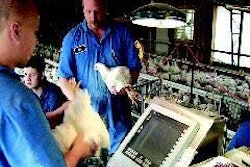Highly pathogenic avian influenza (AI) continues to blaze a trail through Bangladesh despite efforts by veterinary and health service departments. It is now apparent that the virus was given a six-week head start in February and March 2007. No country can afford to give this dynamic and deadly virus that amount of room to spread and not suffer serious consequences, as Indonesia and Nigeria have found to their cost.
The first outbreak was announced on 23 March 2007 at Biman Poultry Complex in Savar (sub-district) of Dhaka (district and division) in Central Bangladesh just outside the capital.
According to subsequent information sent by Government of Bangladesh to OIE (World Organisation for Animal Health), the very first outbreak actually started on 5 February at Naz Poultry Farm (layers) in the Sharishabari sub-district of Jamalpur. Jamalpur distict is also in Dhaka division but several hundred kilometres north of Dhaka city and very close to the border with India.
The outbreak at Biman actually began on 22 February – a whole month before it was announced on 23 March. In between was another outbreak at Jamalpur (layer farm) on 21 February. Farm managers at Biman told the press that over 100,000 chicks were despatched to 58 farms all over Bangladesh between 4 February and 3 March.
The two layer farms affected in Jamalpur were relatively small, housing a combined total of just 3800 birds. Official reports indicate that very few birds died from the disease over what appears to be an extended period of time, leaving almost all to be culled some weeks later.
The Biman outbreak was more obvious as 32,000 birds were affected, 12,000 of which had already died from H5N1 before the cullers got to work. Infections at the two Jamalpur farms were either over-looked or misdiagnosed until the mass death of birds at the Biman Poultry Complex triggered a national response. H5N1 had received a clear run of more than six weeks before quarantine and other measures were established.
Recent infection of five new farms at Savar farms (announced on 21 April) – a whole four weeks after surveillance and quarantine was established at start of the outbreak – was an ominous sign. Given the one-month delay, infections were either missed in late March or quarantine had quickly broken down. Otherwise, it indicates the disease is being spread by wild birds or perhaps feral cats and rodents.
The disease was still spreading during the first week of May. There were six more outbreaks in Jessore district (Khulna division) in western Bangladesh close to the border with West Bengal state in India, and outbreaks in neighbouring Magura district (200km south-west of Dhaka), and Chuadanga district (Khulna division) bordering West Bengal mid-way along Bangladesh’s western border with India. Further outbreaks occurred in Dhaka district, in Savar and Dhaka itself.
In a separate and even more ominous development, a serious outbreak occurred mid-May at the extreme north of Bangladesh in Nilphamari district, Rajshahi division. Nilphamari borders India and is close to a suspected Siliguri outbreak in the northern part of West Bengal state in India*.
To date 157,000 birds have been culled on 53 farms in 11 districts across most of Bangladesh. More than 1.5 million eggs were destroyed since 22 March and 200 million in the first week of May alone. There now appears several main foci of disease including one in and around Dhaka in central Bangladesh, another in Khulna division around middle of the western border with India and a third in the north at Jamalpur and also close to India.
The government claims the situation is not yet grave but the Bangladesh Poultry Association disagrees. “The situation is very grave and a disaster could happen any time. There have been a lot of unreported bird flu deaths in farms and cover-ups”, leading poultry industry expert. M.M. Khan told Khaleej Times.
“The flu [H5N1] is no longer confined to farms. Recently, it infected domestic (household) birds and fowls and there is a real danger it could infect humans in densely populated Bangladesh”, claimed Mr Khan. “The farmers are not reporting bird flu deaths to government authorities for fear of losses in their farms and pressure by adjoining farms.” There is hardly any monitoring, he added, and predicted a ‘South-east Asia-like’ situation if the government failed to step up its fight against the disease.
Bangladesh does not have adequate facilities to detect HN1 and usually sends all samples to Thailand for testing. Last month, the government sought help from the United Nations to set up a testing laboratory, and FAO has apparently agreed to help, but it already looks too late for short-term disease eradication.
The disease is clearly spreading out of control and Bangladesh finds itself in a similar situation to Nigeria in February 2006 when the government waited over three weeks after laboratory confirmation of H5N1 to announce the disease and quarantine measures. The disease spread across Nigeria very rapidly, and this West African country has never managed to get on top of the disease since: H5N1 is now present in almost every state and there is no prospect of eradication.
* It has since been announced that the suspected outbreak in Siliguri was in fact caused by a disease other than H5N1.

















